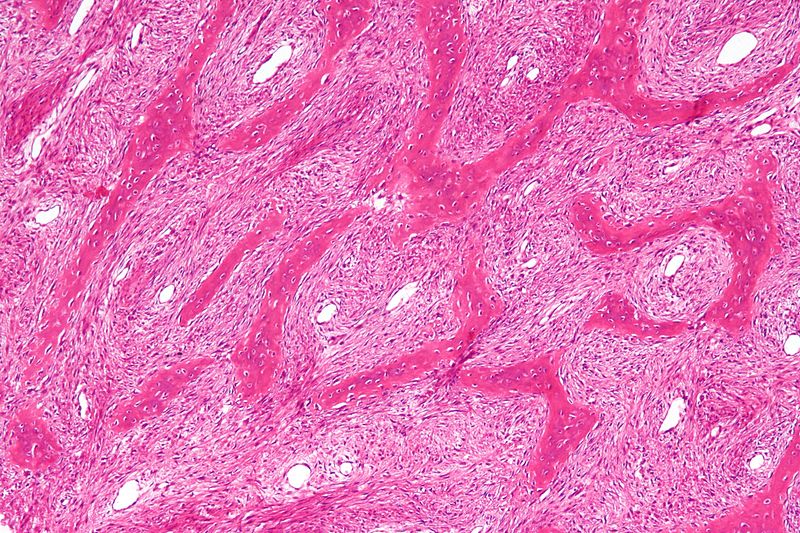WBR0765
| Author | [[PageAuthor::Rim Halaby, M.D. [1]]] |
|---|---|
| Exam Type | ExamType::USMLE Step 1 |
| Main Category | MainCategory::Pathology |
| Sub Category | SubCategory::Musculoskeletal/Rheumatology |
| Prompt | [[Prompt::An 14 year old girl is brought by her mother to the physician's office for facial asymmetry and a limp on the right side. Further questioning reveals that the patient does not experience any facial pain, visual disturbances, or hearing loss. Her limp has been progressively getting worse. Her past medical history is significant for an endocrine disease that is characterized by skin lesions, early breast development, and early menarche Physical examination is remarkable for facial asymmetry and for multiple cafe-au-lair spots on her skin. Xray of the right femur shows a "ground glass" appearance and findings consistent with a "shepherd's crook". The physician tells the patient and her mother that her condition is caused by a disease of the bone marrow stromal cells and abnormal production of fibroosseous masses of tissue. Bone biopsy of the bone lesions will most likely show which of the following findings?]] |
| Answer A | AnswerA::Spindle-shaped cells with multi-nucleated giant cells |
| Answer A Explanation | AnswerAExp::Giant cell tumor (osteoclastoma) is characterized on pathology by spindle-shaped cells with multi-nucleated giant cells |
| Answer B | AnswerB::"Chinese characters" made of bone trabecular |
| Answer B Explanation | AnswerBExp::Fibrous dysplasia of bone is characterized by pathology by "Chinese characters", which are curvilinear trabeculae, made of bone trabeculae. |
| Answer C | AnswerC::Small blue anaplastic cells |
| Answer C Explanation | AnswerCExp::Ewing's sarcoma is characterized on pathology by small blue anaplastic cells. |
| Answer D | AnswerD::High grade spindle cells that produce osteoid matrix with no cartilage connections |
| Answer D Explanation | AnswerDExp::Osteoid sarcoma is characteriezd on pathology by high grade spindle cells that produce osteoid matrix with no cartilage connections |
| Answer E | AnswerE::Small circumscribed irregular trabeculae and sclerotic nidus of woven bone |
| Answer E Explanation | AnswerEExp::Osteoid osteoma is characterized by small circumscribed irregular trabeculae and sclerotic nidus of woven bone. |
| Right Answer | RightAnswer::B |
| Explanation | [[Explanation::Fibrous dysplasia (FD) of the bone is a rare congenital disease caused by mutations in cAMP regulating protein Gs-alpha. As such, bone marrow stromal cells will cause abnormal production of fibroosseous masses of tissue instead of bone. Bone will thus be replaced by fibroblasts, collagen, and irregular bony trabeculae.
The most common form of FD is monostotic, i.e. involving only one bone. In many cases, the bone findings are incidental during radiological work-up, whereas in other cases patients present with a limp due to involvement of the proximal femur or a bulging mass from the ribs. The lesion in FD may be painless or painful. Less commonly, patient have polyostotic involvement. The latter form might be associated with several endocrinopathies in the minority of cases, such as McCune-Albright, which might manifest in young girls as precocious puberty and cafe-au-lait spots. Craniofacial involvement in FD is common, involving the skull base. The disease might be extensive causing severe damage, including visual and auditory disturbances, or present with facial asymmetry, or be clinically not evident whatsoever. On radiological work-up, ground glass appearance of bone is characteristic. If the proximal femur is involved, it appears as a pathognomonic "Sheperd's crook". On pathology, FD appears as "Chines letters", or curvilinear trabeculae, that involve bone trabeculae. Educational Objective: Bone lesions in fibrous dysplasia appear as "Chinese letters" in bone trabeculae. Reference:
Leet AI, Collins MT. Current approach to fibrous dysplasia of bone and McCune-Albright syndrome. J Child Orthop. 2007;1(1):3-17. |
| Approved | Approved::No |
| Keyword | WBRKeyword::fibrous, WBRKeyword::dysplasia, WBRKeyword::bone, WBRKeyword::chinese, WBRKeyword::Chinese, WBRKeyword::letters, WBRKeyword::characters, WBRKeyword::character, WBRKeyword::letter, WBRKeyword::pathological, WBRKeyword::pathology, WBRKeyword::mccune albright, WBRKeyword::McCrune, WBRKeyword::Albright, WBRKeyword::McCune-Albright, WBRKeyword::precocious, WBRKeyword::puberty, WBRKeyword::menarch, WBRKeyword::breast, WBRKeyword::enlargement, WBRKeyword::endocrinopathy, WBRKeyword::endocrinopathies, WBRKeyword::skull, WBRKeyword::proximal, WBRKeyword::femur, WBRKeyword::sheperd, WBRKeyword::sheperd's, WBRKeyword::crook, WBRKeyword::ground, WBRKeyword::glass, WBRKeyword::xray |
| Linked Question | Linked:: |
| Order in Linked Questions | LinkedOrder:: |
